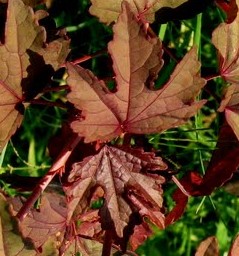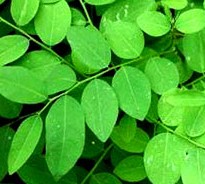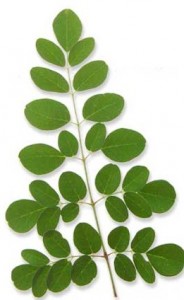I heard about this,and want to look into it for several reasons. First, it offers almost year-round availability here. Second, each plant is tasty from the samples I’ve tried so far. Thirds, its highly nutritious, as well as Paleo!
The three ingredients are katuk, false sorrel, and moringa. Mix in equal parts, and you have a wonderful salad, at least I’d guess it is. I don’t yet have the sorrel or katuk, though they are both in my near future.
Descriptions From Echo:
 Cranberry Hibiscus (False Roselle)
Cranberry Hibiscus (False Roselle)
Hibiscus acetosella
Also known as ‘False Roselle’, this species has striking red leaves similar to a Japanese maple. It can be planted in the spring and kept pruned for an attractive annual shrub and may be grown as a temporary hedge. Cranberry hibiscus is nematode and insect resistant and does well in sandy soil. The young tender red leaves have a tart flavor and are an attractive addition to salads, slaws, or stir fries. In the fall it has pink blossoms. About thirty blossoms can be picked at dusk after they have folded, and blended with lime juice and sugar to make a beautiful and tasty drink. The petals add a bright red color rather than any special flavor.
 Katuk
Katuk
Sauropus androgynus
Katuk, a delicious hot weather green vegetable, is one of the staple vegetables in Borneo. It has become one of the favorite salad greens of the staff at ECHO, and is used either cooked or raw for its nutritious leaves and shoots. The unique flavor of these leaves is most similar to peanuts. It grows very well in Florida. Katuk is disease and pest resistant, tolerates most soils, and grows in sun or shade. For the best tender shoots and leaves, grow Katuk in half shade and fertilize frequently. This shrub should be kept pruned at 3 to 6 feet since it tends to grow straight up until it falls over. It grows very slowly during cool weather, and can be killed back by a frost or freeze but grows back from the ground and may re-grow bushier than before.
 Moringa (Drumstick Tree)
Moringa (Drumstick Tree)
Moringa oleifera syn. M. pterygosperma
Moringa has been one of the most requested seeds in ECHO’s seedbank. This is due to its many edible parts and its ability to survive in arid parts of the world. It is an exceptionally nutritious vegetable tree. The large frilly leaves can be broken off easily at the stem and carried inside. The tiny leaflets can then be quickly pulled off between the fingers. Tender growing tips can be cooked stem and all. At ECHO, leaves are boiled as any green or added to soups or rice. In the southern portions of the United States the tree will probably survive a hard freeze but may be killed to the ground. Even where no freeze damage occurs some people cut it back to about 4 feet each year to force the leaves to be closer to the ground for ease of harvesting. If not forced to branch by pruning, the tree becomes tall, spindly and not very attractive.
===========================
I just tried both False Roselle as well as Katuk. The false roselle was very tangy, almost lemonade sour. The katuk was such a close match to the flavor of peanuts that I’m wondering if I could make some sort of paste out of it and use like peanut butter….the moringa I am trying to grow, but the last time I ate a leaf, I was not impressed with the flavor, it seemed to be mostly a filler. The nutrition value, however, makes it a great idea to add to this salad.
So I’m looking into getting all three. They are low-profile, not looking like they are food growing in the yard, so most wouldn’t bother them. Call it “Stealth Gardening”, if you like, I won’t mind
Peace,
db

Nice article. It is great to find a raw salad in the Florida garden in the summer time. I had a similar experience with Moringa leaf the first time I tried it.. I have since found that there is a markable difference between older and very young leaves of Moringa. You may find the young leaves more palatable. To that end I keep pruning my Moringa so that it is constantly making new shoots and lots of tender young leaves.
I just wish my moringa would grow! It’s been two feet tall for three months!
And BTW, Aunt Nan gave me the idea for the post
db
Cranberry hibiscus or false roselle as it is also known makes a great wine, and I have also made a really tasty jam from the seed pods.
Just wanted to drop a line and let you know how much I enjoy your site/ blog. Have been in the area about 2 years and have been trying alot of new things in the garden, including seminole pumpkin, chayote- merlitons as I know them, yard long beans, and a lot of others. The big winner here has been dragon fruit, they take a while to get going but man are they worth it, Supposedly up to two hundred pounds of fruit per plant by the fourth year.
Again , thanks for all the info,
Bob
Thanks for the kind words
Going to look into dragon fruit now….
db have some mayan spinach trees here if your interested.
Email me and we can make an arrangement. You might want to see the dragon fruit to.
bd
I have some Mayan Spinach tree also growing. I haven’t eaten any yet, though I do know it MUST be boiled first to break down the toxins to make it safe to eat.
Emailing about the dragon fruit
db